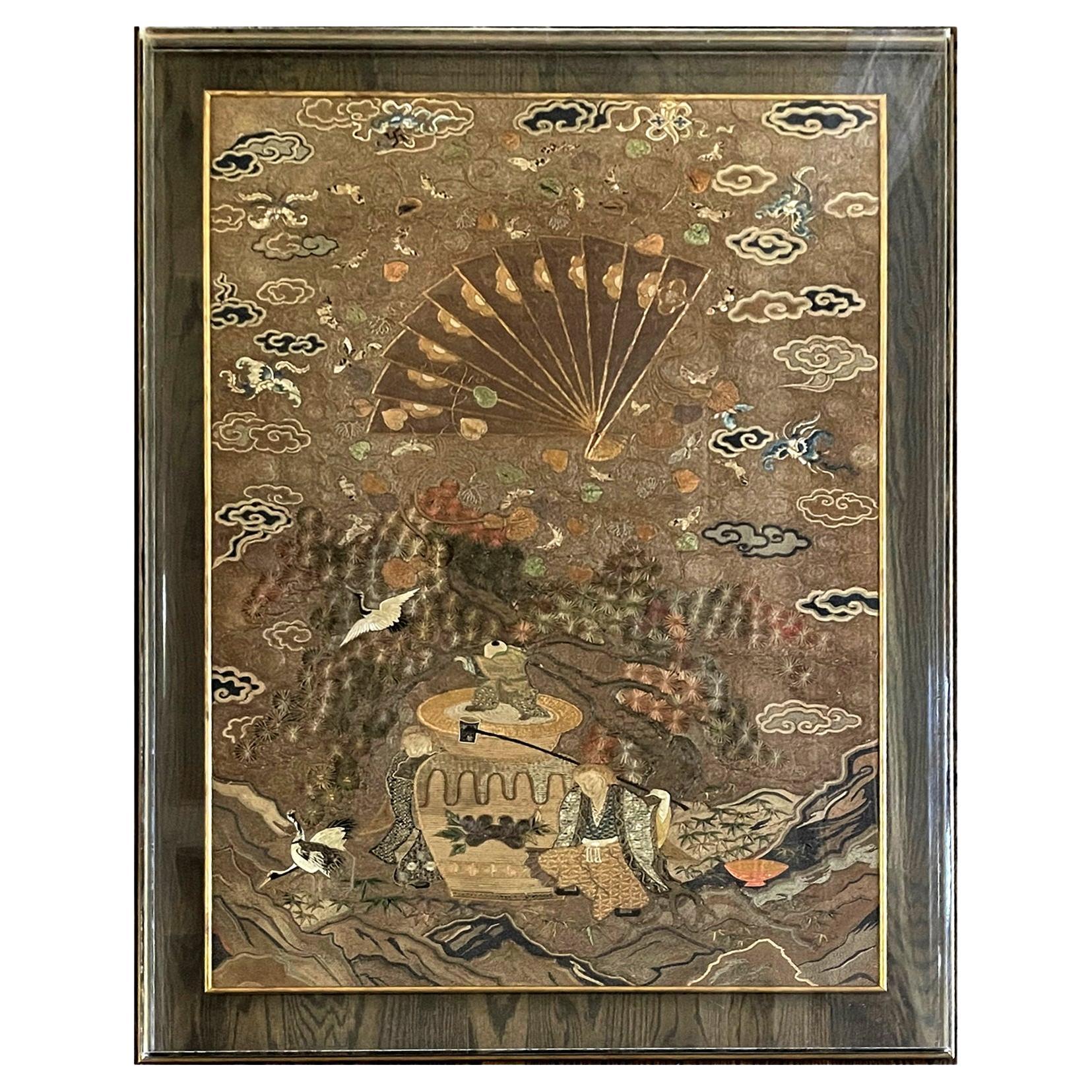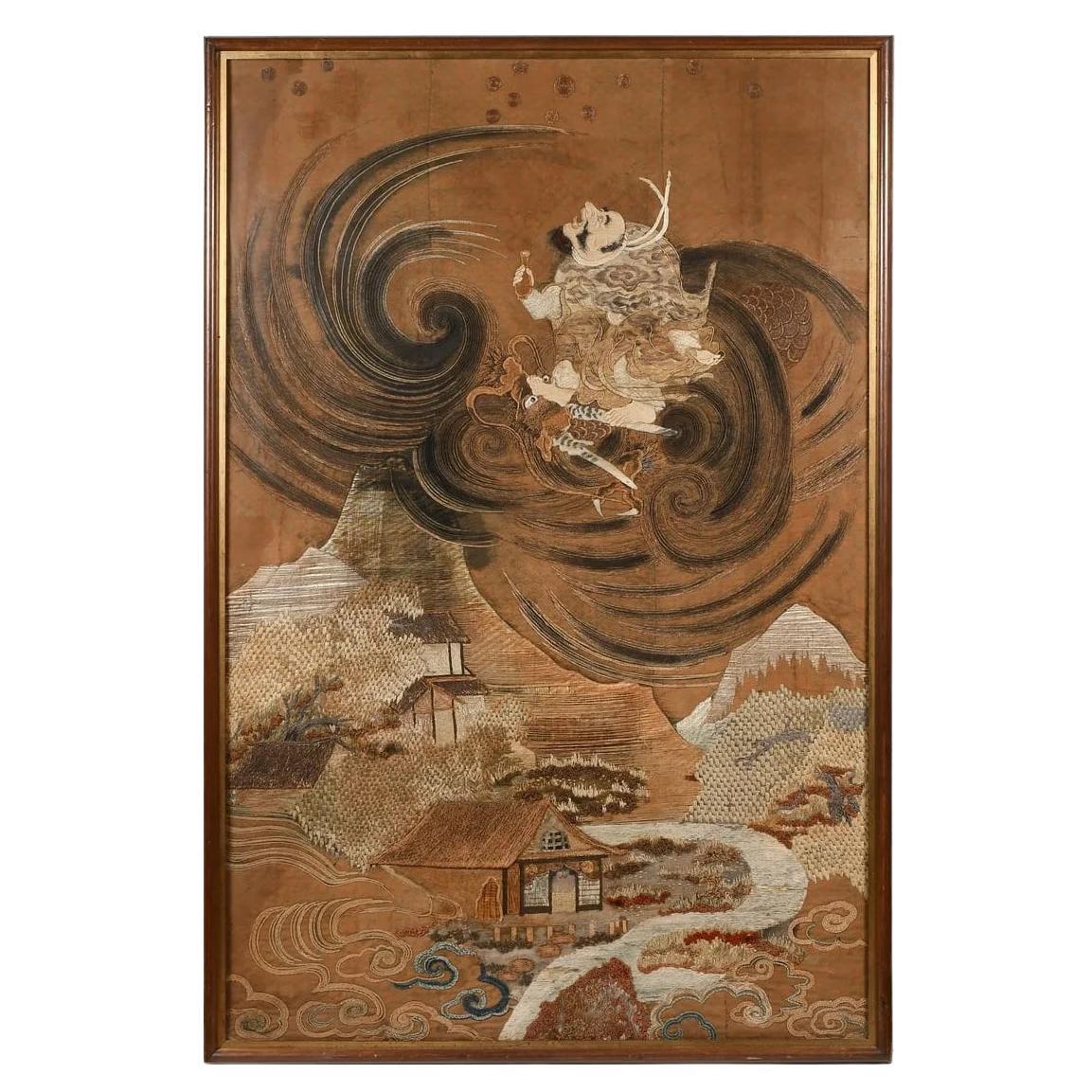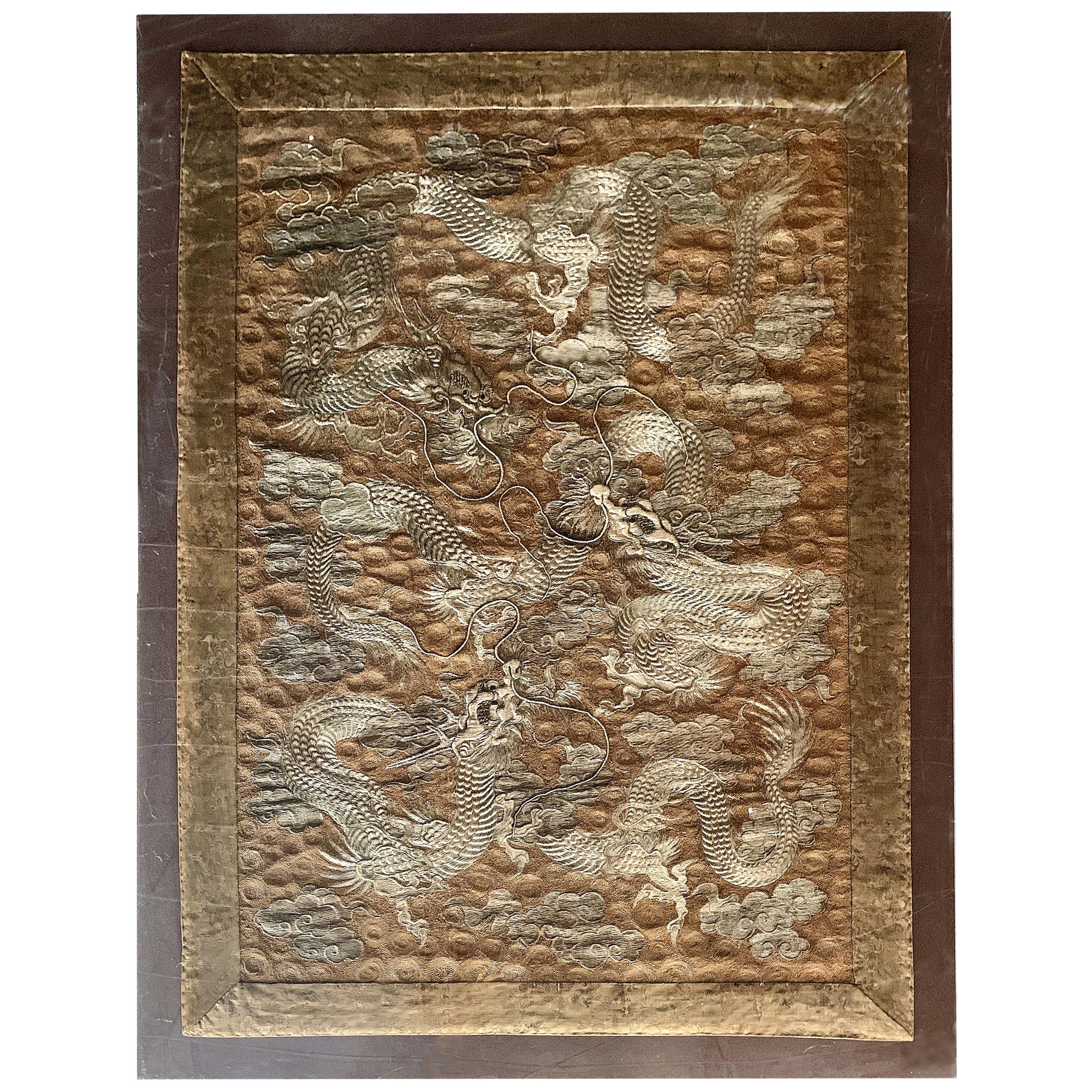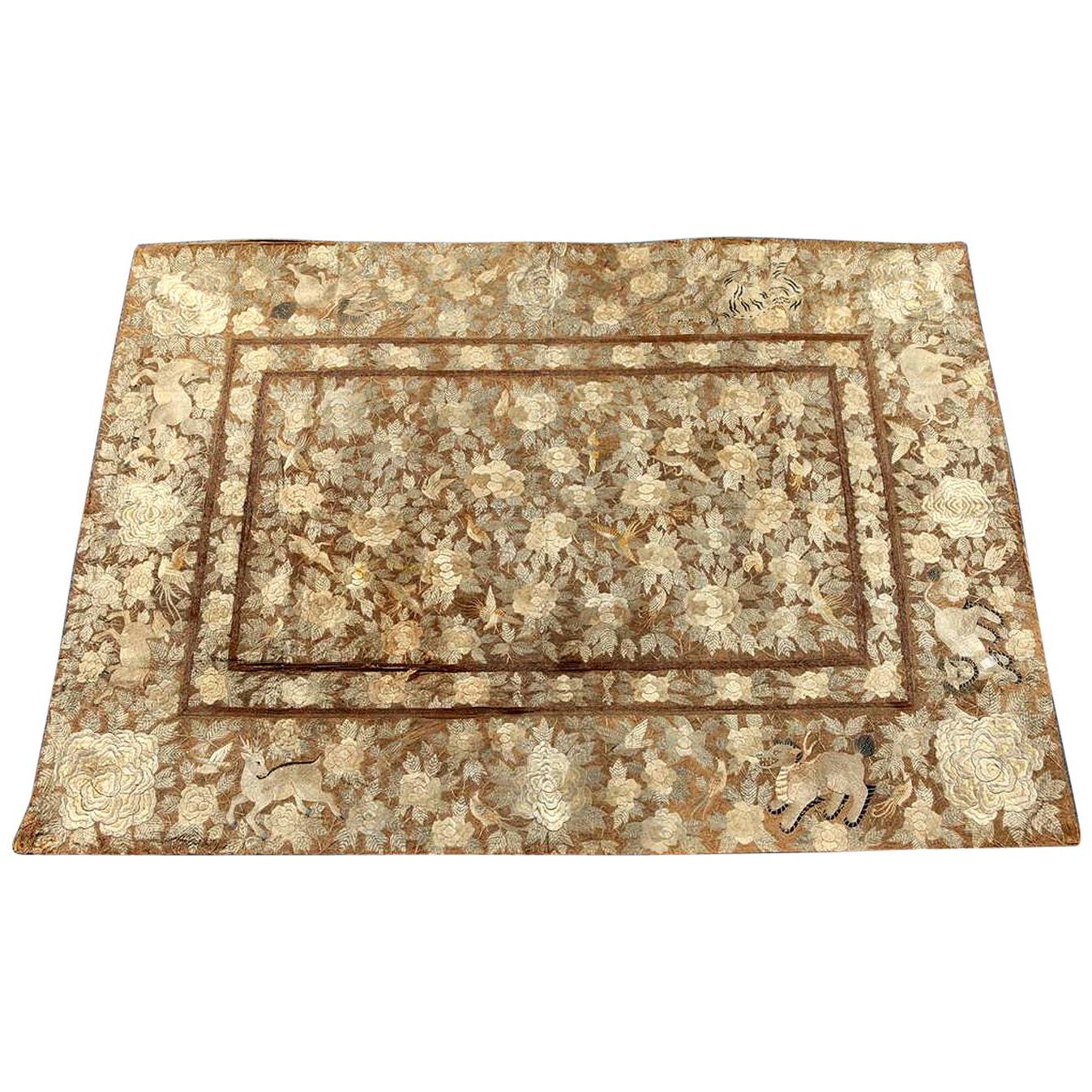Items Similar to Large Japanese Embroidery Tapestry Meiji Period
Want more images or videos?
Request additional images or videos from the seller
1 of 17
Large Japanese Embroidery Tapestry Meiji Period
About the Item
A large and finely embroidered Japanese tapestry with brocade border, circa 1900s Meiji period. The tapestry depicts, in a rather realistic style, a forested landscape in autumn flanking a meandering river. Within the landscape, groups of foxes are hunting wild geese. The center group depicts the exact moment when one bird is being caught. The tapestry was done entirely with different techniques of embroidery and it shows the hunting scene in the natural setting with astonishing details and dimensional sense. This type of large embroidery panels was made to meet the demand of the western market during the exposition period at the beginning of 20th century, when Japanese art from Meiji period took the west by storm and inspired awes and imagination.
Interestingly, this particular piece appears to be heavily influenced by the tapestries from the west, many of which depict idyllic natural scene with animals and often include hunting events. Although many elements such as the swaying grasses, trees with autumn leaves represent Classic Japanese motifs of embroidery work, the subject manner and the emphasis on dimensional depth that was found typically in western landscape painting clearly show that it was made for export to the western market. This "East Meet West" aesthetic was quite unique during 1890s-1920s when Japanese art was discovered through many exposes around the world. The demand of the Japanese decorative art by the west further brought the feedback to the Japanese artisans who were fast to fine tune their craft to the newly found market.
The authorship of this wonderful tapestry is uncertain. Several prominent textile studios/houses such as Nishimura Sozaemon, Lida Shinshichi and Kawashima Jinbei were possible candidates as they all participated in many expositions in Europe and America in early 1900s. It is possible that the tapestry was procured through one of these expositions. Among them, Nishimura is well known for creating large tapestry featuring animals in a realistic manner.
For a piece with similar landscape by Matsunaga & Co, see page 156 of Thread of silk and gold, ornamental textile from Meiji Japan by Ashmolean.
The embroidery panel is 44.5" W by 68" H. It measures 56.5" by 80 with the brocade border. The backing is a beautiful woven green brocade as shown.
- Dimensions:Height: 80 in (203.2 cm)Width: 56.5 in (143.51 cm)Depth: 0.1 in (2.54 mm)
- Style:Japonisme (Of the Period)
- Materials and Techniques:
- Place of Origin:
- Period:
- Date of Manufacture:1900s-1910s
- Condition:Wear consistent with age and use. Unframed. The embroidered panel is of fine condition. The brocade border has some general frays, also small tears and resewing mostly on top edge and corners due to the previous hanging display.
- Seller Location:Atlanta, GA
- Reference Number:1stDibs: LU945020180592
About the Seller
5.0
Platinum Seller
These expertly vetted sellers are 1stDibs' most experienced sellers and are rated highest by our customers.
Established in 2006
1stDibs seller since 2010
479 sales on 1stDibs
Typical response time: <1 hour
- ShippingRetrieving quote...Ships From: Atlanta, GA
- Return PolicyA return for this item may be initiated within 2 days of delivery.
More From This SellerView All
- Japanese Silk Embroidery Tapestry Meiji PeriodLocated in Atlanta, GAA spectacular Japanese embroidered silk panel beautifully presented in a gilt frame suspended in a lucite shadow box with gilt wood border. The silk picture is dated to 1890-1910s toward the end of Meiji Period, when Japanese started to participate international expose by presenting its best art and craft. Elaborate embroidered silk tapestry like this was very popular among westerners due to its superb craftmanship and also exotic subject matter that was often derived from classic Japanese folklore, mythology and various motifs. The tapestry on offer is such an example. It depicts an old couple...Category
Antique 1890s Japanese Japonisme Textiles
MaterialsFabric, Silk, Lucite
- Massive Japanese Embroidery Tapestry Display Box Meiji PeriodLocated in Atlanta, GAA massive Japanese embordered tapestry professionally displayed in a custom acrylic shadow box. The fine work of textile art is dated to 1890-1920s, late Meiji (1868-1912) or possibl...Category
Early 20th Century Japanese Japonisme Textiles
MaterialsBrocade, Silk, Acrylic
- Framed Japanese Antique Phoenix Dragon Embroidery Tapestry Meiji PeriodLocated in Atlanta, GAA visually stunning Japanese embroidery tapestry circa 1890s-1900s late Meiji period, presented with a linen matt with gold trim in a gilt wood frame. The design showcases a flying p...Category
Antique 1890s Japanese Japonisme Textiles
MaterialsSilk, Giltwood
- Framed Japanese Antique Embroidery Sennin Tapestry Meiji PeriodLocated in Atlanta, GAA stunning Japanese embroidery tapestry circa 1880s-1900s from late Meiji period, presented with an original wood frame with inner gold trim. The tour-de-force embroidered tapestry s...Category
Antique 1890s Japanese Meiji Textiles
MaterialsGiltwood, Silk
- Large Framed Japanese Embroidery Dragon TapestryLocated in Atlanta, GAAn impressive Japanese embroidery tapestry circa 1890s Meiji period, presented with brocade border on linen canvas in a Lucite shadow box. The stunning design features three dragons coiling and flying in the clouds. The high relief technique used to render the dragons using mostly the silver threads gives this piece a tremendous sense of motion. The most auspicious mythological creature in Japan and China, dragons were a very popular motif in textile art. In this particular piece, it is the impressive size, the superb craftsmanship, the profuse use of silver threads and near perfect condition that set it apart. Japanese Meiji textiles were widely exhibited in the west during turn of the 20th century at the international exposition. It was used to showcase the Japanese aesthetics with the techniques at their pinnacle. These expositions solidified the country's images overseas and felled the Japanese craze in the west, which turned out to be a long-lasting influence on the western art. Many pieces were purchased and stayed in the west. It is likely this estate piece was from one of the expositions based on its high quality. For two similar dragon tapestries...Category
Antique 1890s Japanese Japonisme Textiles
MaterialsTextile, Lucite
- Antique Japanese Embroidery TapestryLocated in Atlanta, GAA large Japanese silk embroidery tapestry circa 19th century, late Edo to early Meiji period. Meticulously handwork that densely depicts repea...Category
Antique 19th Century Japanese Japonisme Textiles
MaterialsSilk
You May Also Like
- Late Meiji Period Sleeping Kimono / Yogi, JapanLocated in Point Richmond, CALate Meiji Period sleeping Kimono / Yogi, Japan Yogi are a type of oversized sleeping kimono traditionally used in Japan. This kimono would have b...Category
Early 20th Century Japanese Tribal Textiles
MaterialsCotton
- Meiji Period Japanese Indigo Double Ikat Futon CoverLocated in Point Richmond, CAMeiji period Japanese Indigo double ikat futon cover Japanese futon cover, a double ikat pattern in four panels depicting Kumamoto Castle with im...Category
Antique 1890s Japanese Meiji Textiles
MaterialsCotton
- Susani Uzbek Embroidery TapestryLocated in Alessandria, PiemonteOld very elegant "susani" from Uzbekistan - not too large, it's perfect for wall like a picture or a tapestry; else placed on a table or on the back of a sofa. ref. B/2433.Category
21st Century and Contemporary Uzbek Other Textiles
MaterialsSilk
- Japanese Asian Large Meiji Period Silk Embroidery Peacock Bird Flower TapestryLocated in Studio City, CAA stunning Meiji Period (1868-1912) Japanese large framed embroidery/ tapestry featuring a pair of finely detailed birds - likely peacocks in a floral garden landscape. A truly magn...Category
Antique 19th Century Japanese Meiji Tapestries
MaterialsSilk, Glass, Wood
- Japanese Indigo Dyed Old Embroidery Cloth / Japanese Toy Pattern / 1912-1960Located in Sammu-shi, ChibaIt is a Japanese indigo dyed antique cloth. It calls its name "fu-ro-shi-ki". Originally used in the dressing room of the public bath "furo" during the...Category
Early 20th Century Japanese Showa Textiles
MaterialsCotton
- "BORO" / Japanese Old Cloth / Tapestry / Wall DecorationLocated in Sammu-shi, ChibaWe have a unique Japanese sense of beauty. We will also introduce unique items that only we can make, purchasing routes in Japan, experience gained so far, and methods that no one el...Category
Early 20th Century Japanese Showa Textiles
MaterialsCotton, Linen
Recently Viewed
View AllMore Ways To Browse
Unique Textile
Large Japanese
World Textiles
Japanese Motif
Embroidery Textile
Artisan Textile
Early American Period Furniture
Large Textile Art
Embroidery Embroidered
Japanese Inspired Furniture
Japanese Textile
Japan Textiles
Japanese Motif Furniture
Antique Embroidery Embroidery
Antique Embroideries
Antique Embroidery
Embroidery Antique
Japanese Influence Furniture





